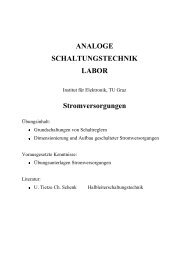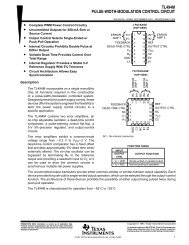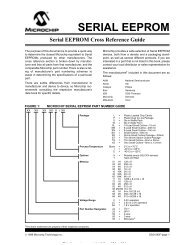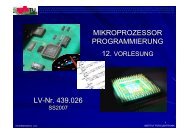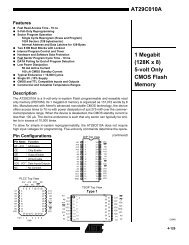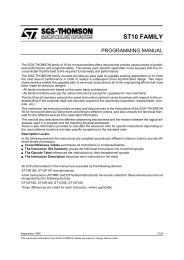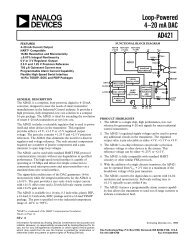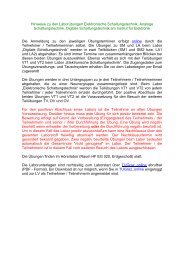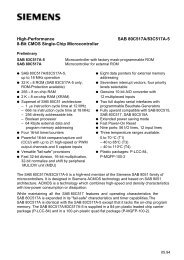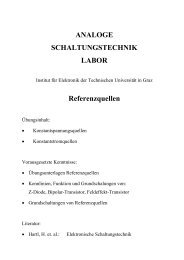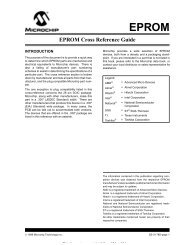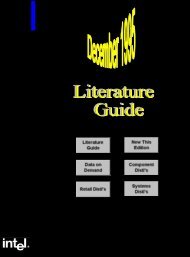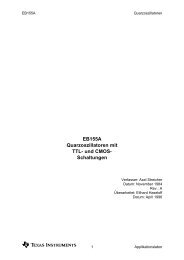AN61-1 Application Note 61 August 1994 Practical Circuitry for ...
AN61-1 Application Note 61 August 1994 Practical Circuitry for ...
AN61-1 Application Note 61 August 1994 Practical Circuitry for ...
Create successful ePaper yourself
Turn your PDF publications into a flip-book with our unique Google optimized e-Paper software.
<strong>Application</strong> <strong>Note</strong> <strong>61</strong>Per<strong>for</strong>mance <strong>for</strong> the circuit is quite impressive. Figure 23plots error from DC to 11MHz. The graph shows 1% errorbandwidth of 11MHz. The slight peaking out to 5MHz isdue to the gain boost network at A2’s negative input. Thepeaking is minimal compared to the total error envelope,and a small price to pay to get the 1% accuracy to 10MHz.To trim this circuit put the 5kΩ potentiometer at itsmaximum resistance position and apply a 100 mV, 5MHzsignal. Trim the 500Ω adjustment <strong>for</strong> exactly 1V OUT . Next,apply a 5MHz 1V input and trim the 10k potentiometer <strong>for</strong>10.00V OUT . Finally, put in 1V at 10MHz and adjust the 5kΩtrimmer <strong>for</strong> 10.00V OUT . Repeat this sequence until circuitoutput is within 1% accuracy <strong>for</strong> DC-10MHz inputs. Twopasses should be sufficient.It is worth considering that this circuit per<strong>for</strong>ms the samefunction as instruments costing thousands of dollars. 4ERROR (%)10–1010.7% ERROR AT 10MHz2 3 4 5 6 7 8 9 10 11FREQUENCY (MHz)<strong>AN<strong>61</strong></strong> F23Figure 23. Error Plot <strong>for</strong> the RMS/DC Converter.Frequency Dependent Gain Boost at A2 Preserves 1%Accuracy, But Causes Slight Peaking Be<strong>for</strong>e Roll-OffHall Effect Stabilized Current Trans<strong>for</strong>merCurrent trans<strong>for</strong>mers are common and convenient. Theypermit wideband current measurement independent ofcommon-mode voltage considerations. The most conve-nient current trans<strong>for</strong>mers are the “clip-on” type, commerciallysold as “current probes.” A problem with allsimple current trans<strong>for</strong>mers is that they cannot sense DCand low frequency in<strong>for</strong>mation. This problem was addressedin the mid-1960’s with the advent of the Hall effectstabilized current probe. This approach uses a Hall effectdevice within the trans<strong>for</strong>mer core to sense DC and lowfrequency signals. This in<strong>for</strong>mation is combined with thecurrent trans<strong>for</strong>mers output to <strong>for</strong>m a composite DC-tohighfrequency output. Careful roll-off and gain matchingof the two channels preserves amplitude accuracy at allfrequencies. 5 Additionally, the low frequency channel isoperated as a “<strong>for</strong>ce-balance,” meaning that the lowfrequency amplifier’s output is fed back to magneticallybias the trans<strong>for</strong>mer flux to zero. Thus, the Hall effectdevice does not have to respond linearly over wide rangesof current and the trans<strong>for</strong>mer core never sees DC bias,both advantageous conditions. The amount of DC and lowfrequency in<strong>for</strong>mation is obtained at the amplifier’s output,which corresponds to the bias needed to offset themeasured current.Figure 24 shows a practical circuit. The Hall effect transducerlies within the core of the clip-on current trans<strong>for</strong>merspecified. A very simplistic way to model the Hallgenerator is as a bridge, excited by the two <strong>61</strong>9Ω resistors.The Hall generator’s outputs (the midpoints of the“bridge”) feed differential input transconductance amplifierA1, which takes gain, with roll-off set by the 50Ω,0.02µF RC at its output. Further gain is provided by A2, inthe same package as A1. A current buffer provides powergain to drive the current trans<strong>for</strong>mers secondary. Thisconnection closes a flux nulling loop in the transducercore. The offset adjustments should be set <strong>for</strong> 0V outputwith no current flowing in the clip-on transducer. Similarly,the loop gain and bandwidth trims should be set sothat the composite output (the combined high and lowfrequency output across the grounded 50Ω resistor) hasclean step response and correct amplitude from DC tohigh frequency.<strong>Note</strong> 4: Viewed from a historical perspective it is remarkable that so muchprecision wideband per<strong>for</strong>mance is available from such a relatively simpleconfiguration. For perspective, see Appendix A, “Precision Wideband<strong>Circuitry</strong> . . . Then and Now.”<strong>Note</strong> 5: Details of this scheme are nicely presented in Reference 15.Additional relevant commentary on parallel path schemes appears inReference 7.<strong>AN<strong>61</strong></strong>-18



